Angus Henderson, Lockheed Martin Aculight
Infrared laser spectroscopy is a powerful technique that allows unique identification of chemical species as well as study of their properties. Measuring absorption as a function of wavelength enables chemists to obtain spectra of compounds that are a unique reflection of their molecular structure.
The wavelength region between 3.0 and 3.7 μm (2750 cm−1 and 3300 cm−1 in frequency) is particularly important because it contains virtually all the characteristic stretching frequencies of molecules containing carbon-hydrogen bonds. The strength of the fundamental absorptions in this so-called “C-H stretch” region can be orders of magnitude higher than overtone absorptions of the same molecules in the near-infrared (<2-μm wavelength). For example, the absorption of methane at 3.3 μm is more than 100 times stronger than in its overtone band at 1.65 μm (Figure 1). As a result, narrowband tunable lasers operating in the C-H stretch region can be used to perform highly sensitive detection of hydrocarbon species, as well as more fundamental investigations of molecular structure and chemical reactions.
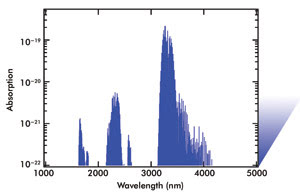
Figure 1. Methane absorption strength vs. wavelength (HITRAN database: www.cfa.harvard.edu/hitran/).
Such sensitive hydrocarbon molecule detection could enhance capabilities in many applications. Potential applications for mid-infrared laser-based detection of organic molecules include analysis of human breath for medical diagnostics, detection of impurities in industrial process gases (e.g., in semiconductor wafer manufacture), airborne natural gas pipeline leak detection and monitoring industrial greenhouse gas emissions. Implementation of these techniques is showing promise, as new mid-infrared laser sources are proving themselves useful and robust spectroscopic tools in the research laboratory.
Lasers for spectroscopy
Currently, mature tunable laser technology exists primarily in the near-infrared region, with emission wavelengths below 2 μm. Titanium-sapphire and dye lasers1 provide high power (watts) and wide tunability (hundreds of nanometers) in the 400- to 1000-nm range. External-cavity diode lasers provide widely tunable, lower power output (milliwatts) covering wavelengths up to approximately 2 μm. Above 4 μm, external cavity quantum cascade lasers2 now are being offered commercially and are opening up new possibilities for spectroscopy in the long-wavelength infrared “fingerprint region.”
However, in the 3- to 4-μm range, there are as yet no commercial semiconductor sources that provide wide tunability. Although interband cascade lasers show promise,3 currently the growth of this kind of semiconductor material remains challenging. To date, the most capable tunable lasers in this spectral region have been color center lasers. These use alkali halide or oxide crystals as gain media, and they provide output in the 2.4- to 3.6-μm range. They operate at cryogenic temperatures with typical output powers of tens of milliwatts and are pumped using a krypton ion laser. Although the color center laser has provided substantial capability for spectroscopy, the size, complexity and difficulty with maintenance have been substantial drawbacks, and they are no longer available commercially.
CW OPOs fill the 3- to 4-μm gap
In addition to lasers directly emitting within the 3- to 4-μm region, widely tunable emission in this range is also possible by nonlinear frequency conversion of more mature near-infrared sources. Products based on difference frequency generation between two distributed feedback diode lasers have been offered commercially. These devices typically produce submilliwatt output and tuning of approximately 100 nm per device.4
Optical parametric oscillators (OPOs), by contrast, provide a pathway to much wider tuning and higher power output in this spectral region. Although the first CW OPOs have been commercially available since 2000, the emergence of fiber lasers as pump sources has transformed OPO capabilities. The most important advance is that the pump power level is sufficient to operate the OPO as a singly resonant oscillator, where only one of the three interacting wavelengths is resonant. This allows straightforward monotonic tuning.
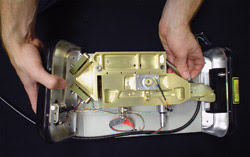
Figure 2. Aculight Argos OPO modules consist of a quasi-monolithic resonant OPO cavity mounted on a pump laser pointing unit. Here the fiber laser collimator is shown being inserted into the pointing unit.
Lockheed Martin Aculight’s Argos, launched in 2007, is the first truly singly resonant CW OPO product. The Argos systems provide multiwatt output powers at both signal and idler wavelengths, linewidth of <1 MHz and mode-hop-free tunability of >50 GHz. They are configured as quasi-monolithic resonant cavities (Figure 2) with a keyed fiber input collimator acting as a connector to a prealigned OPO module. Three interchangeable OPO modules tune from 1.46 to 3.9 μm. The fiber-coupled pump source and monolithic OPO design make the system turnkey, so no “tweaking” is required to maintain alignment. As a result, these OPO systems are finding wide application in major research laboratories around the world for a variety of spectroscopic investigations.
Applications in chemistry
At the University of Georgia in Athens, Gary Douberly’s research group uses high-resolution infrared laser spectroscopy to study novel molecular species isolated in cold 0.4-K helium nanodroplets. Low-temperature helium droplets provide a unique environment in which to probe the structural properties of the isolated molecules. The group is using an Aculight Argos CW OPO system in combination with a helium nanodroplet instrument to make the spectroscopic measurements. The researchers have added additional controls to a standard OPO system, allowing them to collect wide-range spectra. Synchronizing the fine- and coarse-tuning control mechanisms via a PC allows the OPO to collect high-resolution spectra over hundreds of nanometers (Figure 3).
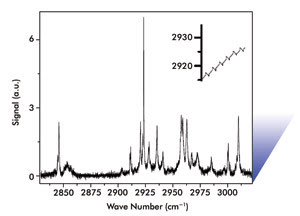
Figure 3. Shown is a depletion spectrum of methanol, recorded using a helium nano-droplet spectrometer in combination with a CW OPO. The inset shows the wavelength meter reading for part of the computer-controlled scan, made up of overlapping 50-GHz mode-hop-free scans. After acquisition, data is reconstructed and plotted via a LabView program. Courtesy of the University of Georgia.
These wide scans allow the group to investigate the evolution of the infrared spectra of hydrocarbon molecules after they undergo reactions with various metal clusters within the helium droplets. Reactions between metal clusters and molecular species such as methane, ethylene and acetylene show up as qualitative changes in the infrared spectra. Full automation of the OPO’s tuning enables exceptionally wide, high-resolution measurement of the entire C-H stretching range (approximately 300 nm) characteristic of hydro-carbon molecules in about 3 h, with no user intervention.
At the École Polytechnique Fédérale de Lausanne (EPFL) in Switzerland, professor Rainer Beck and his research group are studying chemical reactions between gas molecules and solid surfaces. Processes in surface chemistry such as heterogeneous catalysis and chemical vapor deposition are important in many industrial implementations, such as catalytic conversion in automobiles and semiconductor growth in the electronics industry. In Beck’s laboratory, researchers are studying the effects of laser excitation in such processes. The results of these experiments provide stringent tests for theoretical models of gas-surface chemistry.
The group is currently using an Aculight Argos CW OPO to study the reaction of methane with a nickel catalyst. The OPO prepares a beam of methane molecules in a specific excited state. To preserve the molecules in this state, the preparation is performed under collision-free conditions in a molecular beam (Figure 4), whereby the absorption feature is reduced to less than a few megahertz in width. The high spectral resolution and high power of the OPO allow vibrational transitions to be excited into saturation (Figure 4) where approximately 50 percent of the molecules are in a single quantum state. The wide tunability of the OPO makes it a highly versatile source for this study, and the researchers anticipate using it in the future to extend their studies to a variety of molecular species and absorption features.
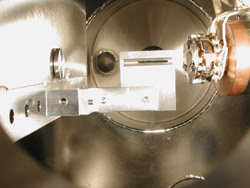
Figure 4. Shown is an École Polytechnique Fédérale de Lausanne (EPFL) surface science apparatus. The molecular beam exits the aperture (left), traverses the alignment tool (center), where laser excitation takes place, and collides with the single crystal metal surface mounted in the center of the sample holder (right).
Applications in chemical sensing
Professor Frans Harren leads the Life Science Trace Gas Facility at Radboud University Nijmegen in the Netherlands. The group has developed state-of-the-art laser-based trace gas detectors that are used for research in areas from plant physiology to medicine and human health. Harren and his colleagues use a variety of lasers combination with sensitive detection schemes, including photoacoustic spectroscopy and cavity ring-down spectroscopy.
The team’s recent experiments have challenged the findings of a published study that asserted that emission of significant amounts of methane from plants may play a significant role in the global atmospheric concentration of this powerful greenhouse gas.
By growing plant samples in the presence of carbon dioxide molecules based on the stable isotope of carbon 13C, any methane emitted by the plants could be identified by the presence of this isotope in the methane molecule. Researchers performed trace methane detection with the photoacoustic technique using a singly resonant CW OPO pumped by a diode-pumped solid-state laser operating at approximately 3.24 μm (Figure 5). The OPO’s high power level allowed a 13CH4 detection limit of three parts per billion to be attained using the OPO spectrometer. This is well below the naturally occurring level of 13CH4 in the atmosphere. Monitoring the 13CH4 level showed that there was not a statistically significant level of methane emission from the plants, contradicting the original published finding.
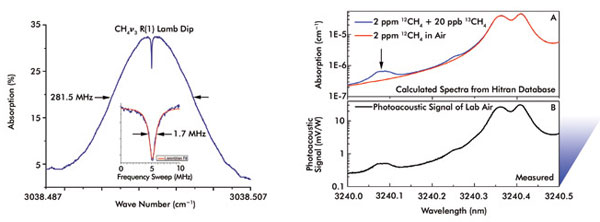
Figure 5. (left) This graph shows methane spectra calculated from a Hitran database. The arrow indicates the °C peak used for measurements. (right) This chart illustrates the photoacoustic spectra of laboratory air. Courtesy of Radboud University.
Looking ahead
It appears likely that, with time, new types of semiconductor lasers may emerge as the lowest cost pathway for laser emission in the 3- to 4-μm region. However, the high power, wide tuning and robust physical characteristics of OPOs, especially those pumped by fiber lasers, make these sources important spectroscopic tools in today’s research laboratories. These same attributes also make OPOs promising for in-the-field applications in industry, medicine and sensing.
Meet the author
Angus Henderson is a principal scientist at Lockheed Martin Aculight. He can be reached at [email protected].
References
1. F.J. Duarte, ed. (1995). Tunable Lasers Handbook. Academic Press, pp. 167-291.
2. E. Takeuchi et al. (January 2009). Quantum-cascade lasers: applications multiply for external-cavity QCLs. Laser Focus World, pp. 83-86.
3. G. Wysocki et al. (Nov. 20, 2007). Dual interband cascade laser-based trace-gas sensor for environmental monitoring. Applied Optics, pp. 8202-8210.
4. Scherer, James J. (Oct. 1, 2007). Nonlinear optics: quasi-phase-matched DFG lasers for sensing enter the market. Laser Focus World, pp. 103-106.